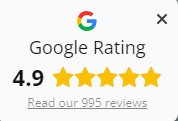Running Rigging: Know your Ropes
There are a myriad of different lines available for use as a halyard, sheet or control line, but which ones will suit your rigging systems best? This article from Jimmy Green Marine, should help you to understand the technical jargon when making your next purchasing decision.
Published 3 months ago
If you pick the right rope for the job, it should perform well, last longer and save you the time and extra cost of replacing it so often.
Let’s look at the manufacturing process, beginning with the fibres used to make the rope, i.e. what it is made of, and then go on to rope construction, i.e. how it is woven together.
You need to get your head around these two main factors. Once you have a working knowledge of them and what they are designed to achieve, you should be able to discern between different ropes.
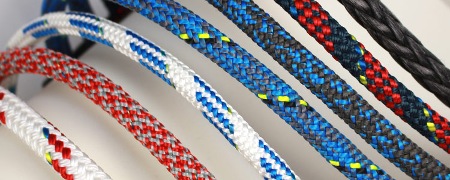

Some ropes are all-rounders, a solid choice for most rigging applications and a safe bet, but not necessarily the absolute best for every aspect of the rig. But if you know your stuff, you should be able to select your lines on a ‘horses for courses’ basis. By specifying each line individually for the task it will perform onboard, you should see a benefit in improved efficiency, performance and, as a bonus, value for money.
Of course, there are other factors in play. The quality of the source fibre and the rope manufacturer will determine how good the rope is against similar competing ropes.
Rope Fibres
Five main rope fibres cover most running rigging applications, whether you are cruising or racing.
They are Polypropylene, Polyester, Technora, Dyneema and Vectran – in order of cost from the most economical to the most expensive.
1. Polypropylene
Polypropylene is the cheapest fibre. It is very light and doesn’t absorb water, so it floats. However, it is stretchy and doesn’t last well in the sun, consequently losing strength far quicker than the other middle-ground fibres such as Nylon or Polyester.
A quick note here to say that Polyamide, commonly known as Nylon, is not recommended for any rigging application unless, for some special reason, you want the rope to stretch (mooring or anchoring warps, for instance) because that is what will happen.
2. Polyester, also commonly known as Terylene or Dacron
Polyester has excellent UV resistance, dependable strength, and acceptably low stretch characteristics when heat set. For all those reasons, it is the go-to fibre for rope manufacturers to produce most of their cruising lines.
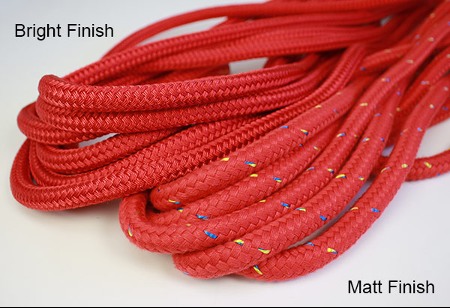

There are two variations of Polyester fibre:
Bright Finish
The yarn is a continuous monofilament, delivering good linear tensile strength. The lines are heat-set, also referred to as pre-stretched, during production to deliver low enough stretch for cruising purposes, e.g. LIROS Braid-on-Braid EVO Bright Polyester.
Matt Finish
The yarn is spun – produced from multiple, relatively short lengths twisted together in a staggered, overlapping fashion. As a result, spun yarn is not as strong and has a bit more give but has a softer, furrier feel in the hand. Ropemakers use spun yarn for the outer cover of a double-braided line where handling is a primary consideration, e.g. LIROS Matt Plait Polyester and LIROS Top Grip.
3. Aramid – also known as Kevlar, Technora or Twaron
These days, rope manufacturers don’t tend to use Aramid so much as a core in double-braided lines because of the advent of Dyneema, which has similar low stretch properties but much better resistance to failure around tight radius corners. Aramid is now more generally used for blending into the polyester fibres in the outer braid of a double-braided line to maximise heat and cut resistance. The Technora content enhances the rope’s resilience to overheating and chafing, making it ideal for working hard around winches.
4. Dyneema
Dyneema (technically, High-Modulus Polyethene) is stronger, but lighter, than stainless steel wire, is hydrophobic (meaning it repels water), floats, and has good chemical and UV resistance.
Dyneema is now the preferred high-tech, high-strength, low-stretch fibre that has superseded Kevlar in yachting ropes.
Dyneema is available in different grades denoted by an SK number.
- SK75 and SK78 are initially similar in strength and stretch with SK75 having slightly less creep. SK75 and SK78 can be treated in production to enhance linear spliced strength and reduce both stretch and creep, e.g. Marlow SK78 Max and Hampidjan’s Dynice Dux.
- SK99 is the ultimate supreme specification.
These three Dyneema grades can be heat-set super-stretched to deliver the highest strength and lowest stretch performance.
Dyneema can be impregnated with a protective polyurethane coating to enhance UV resistance. Look for whether this has been an extra treatment during the rope manufacturing process, although polyurethane is available to purchase separately, so it can also be applied retrospectively.
The price advantage over Vectran (see below), combined with superior flexibility, makes Dyneema the most popular choice for rope manufacturers at the upper end of the performance range for running rigging.
Dyneema ropes are relatively expensive compared with polyester and consequently only customarily associated with Regatta or Racing Performance. However, yacht rope manufacturers have introduced more affordable cruising versions, making them an attractive upgrade to the wider yachting fraternity, which would otherwise only be interested in conventional polyester lines for their boats.
Dyneema core ropes are also excellent for bigger cruising yachts over 45 feet where 100% polyester lines may need to be 16mm diameter and upwards to withstand the required working loads with acceptable stretch performance. For example, 18mm diameter and above will not only require unnecessarily large and expensive clutches, blocks and sheaves, but may also be too unwieldy for your crew to handle comfortably.
5. Vectran
Vectran is a recent addition to the fibres that rope manufacturers design into their yacht ropes. Vectran has similar strength and stretch properties to Dyneema but doesn’t fare as well around tight radius corners or last nearly as long in the sun. Vectran does have the advantage, however, of zero creep. But creep isn’t something that needs to be top of your list of concerns for running rigging, because Vectran isn’t required for most sailing adventures.
Let’s not get too technical, but here is a quick explanation of the difference between Creep and Stretch.
Don’t Confuse Creep with Stretch
Creep is defined as non-recoverable elongation. Stretch is defined as recoverable elongation. Therefore, zero creep effectively means that there will be no retraction after full loading.
Ropes can be manufactured to exhibit near-zero creep, but this isn’t required for Running Rigging. Zero Creep is more suited to Standing Rigging where constant adjustment isn’t desirable, and the associated fittings are designed to withstand the transmitted loads.
Although super-prestretched Dyneema will generally still exhibit some degree of recoverable elongation, it is fine for Running Rigging, even for the most incredibly high-tech objectives.
Marlow Definitive Guide to Dyneema
Rope Construction
Braid-on-Braid, also known as Doublebraid
Yacht Ropes for Running Rigging are mostly manufactured as a combination of two tubular braids, one inside the other, which is how the common names have evolved: Braid on Braid and Doublebraid. The outer braid is known as the cover or jacket. The inner braid is generally referred to as the core.
For most yacht rope manufacturers, Polyester’s reliability and all-round performance for strength, stretch, abrasion and UV resistance make it the go-to fibre for running rigging. The quantity of fibre is divided fairly equally between the cover and the core for 100% polyester lines., although LIROS tend towards a slightly greater percentage in the cover to improve abrasion resistance.
Some braided lines are available with a polypropylene core. This will result in a weaker, stretchier version and is not recommended for important rigging applications.
Braid-on-Braid can be spliced with excellent results, providing a strong and secure termination for attachment.
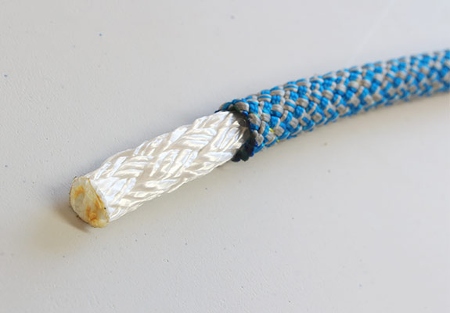

Braid-on-Laid
Marlowbraid has a loosely twisted core, which marginally reduces the stretch for a modest price increase. Unfortunately, the spiral structure of the core flattens when compressed, e.g. around sheaves and winches. Marlowbraid also requires a different splicing method.
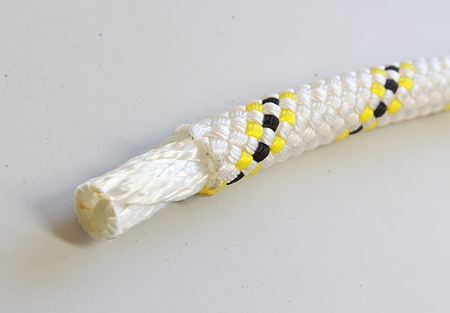

The Outer Braid, known as the Cover or Jacket
The outer cover will bear the brunt of any abrasion.
Increasing the number of plaits or tightening the weave enhances the wear resistance but lessens the flexibility.
Rope manufacturers produce rope with several braids, referred to as plaits: 8plait, 16plait, 24plait, 1:1plait, 32plait, where 8plait will be the most flexible and 32plait will be the most wear resilient.
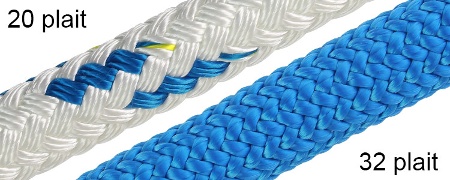

Blending Different Rope Fibres
Rope manufacturers select the core and cover fibres to maximise their star qualities. They also use blending techniques to further enhance their performance for specific applications.
Here are some blending examples:
- Polypropylene/Dyneema for lightweight, racing sheets, e.g. Marlow Excel Fusion
- Technora/Polyester for improved heat, cut and chafe resistance around winches
The Inner Rope Core
Polyester Core with Polyester Cover = 100% Polyester for Cruising
The core of regular Running Rigging lines for cruising yachts is generally 100% Polyester.
As mentioned above, a braided core creates a more solid, rounded rope, even under load.
High-Tech Core with Polyester Cover = Hybrid for Enhanced Performance
Utilising the increased strength and reduced stretch of Dyneema and Vectran in the core instead of Polyester can significantly improve the line’s performance, where performance typically means lower stretch and higher tensile strength.
Ropes with a Polyester cover and Dyneema core may still be referred to as ‘Dyneema’ around the boat park, the marina and in the bar, which can be confusing.
Ropes with a Polyester cover and a higher-tech core (Dyneema, Vectran) require a different splicing method to the braid-on-braid splice to maintain strength and security. This is known as the Core-Dependent Splice.
Dyneema and Vectran are much more expensive than polyester, so the price of the finished rope correlates directly to the proportion of Dyneema/Vectran content.
Two main factors in determining a Dyneema core line’s performance (see above) are the quantity of Dyneema content and the Dyneema SK rating.
Rope manufacturers can adjust the Dyneema content to produce ‘Cruising’ and ‘Racing’ Dyneema running rigging lines. ‘Racing’ Dyneema lines have a 100% Dyneema core.
‘Cruising’ Dyneema lines will not be quite as strong or have such a low stretch as ‘Racing’ Dyneema. This is generally achieved by one of these methods:
- Blending the Dyneema with a lower grade fibre e.g. Marlow D2 Club Cruising Dyneema
- Inserting an intermediate ‘filler’ core between the jacket and the thinner Dyneema braid to bulk out the finished rope, e.g. LIROS Dynamic Plus Cruising Dyneema
This intermediate layer is removed for a short section to enable the completion of the core-dependent splice.


Single Braid or Hollowbraid Construction
These ropes comprise a single tubular braid with no inner core. 12 or 16 Strand is common. Note that the braids or plaits are sometimes referred to as Strands by the Rope Manufacturers. Hollowbraid is very spliceable, meaning the method is relatively easy compared to more complex braid splicing. It is also exceptionally strength-retentive when executed proficiently according to the manufacturer’s specifications.
The major examples of single braids are 100% Dyneema 12 strand, such as LIROS D Pro and Marlow Excel D12, 100% Polyester 12 Strand, such as LIROS Lazyjack, and 100% Multifilament Polypropylene 16Plait for floating safety lines.
Know Your Ropes Summary
- 100% Polyester is the norm for Cruising.
- Braid-on-Braid (Doublebraid) is a firm, solid, spliceable construction.
- Braid-on-Braid Polyester is the best all-rounder for cruising.
- Upgrade to a Dyneema core for improved performance.
- The percentage of Dyneema in the core equates to performance.
- Decide between ‘Racing’ and ‘Cruising’ Dyneema based on desirable uptick and affordable cost.
- More Plaits in the cover normally mean less wear and tear.
- Blending Technora into the cover further enhances abrasion resistance.
- Single hollow braids can be 100% Dyneema for high-tech applications.
…………………………
![]()
About the Author
Jimmy Green Marine is a family-run business founded by brothers Alistair and Mike Green, based in the coastal fishing village of Beer in East Devon. The company started as a Mail Order Chandlers in 1981 and has continually evolved from attending Boat Shows and Boat Jumbles in the early days to now trading globally online.
Four decades of exporting experience combined with an intuitive website shipping calculator means that you can have your order delivered to your home, business or direct to your yacht anywhere worldwide.
Their flagship, innovative Custom Build website system provides an instant quote for all your professionally spliced and finished wire and rope rigging, mooring and anchoring solutions.
You can access this online from wherever you can get an internet connection, however remote.
Alistair Green is an experienced sailor and rigger with over 40 years of experience in the marine industry. He is passionate about providing his customers with the best possible products and services and is always looking for new ways to improve the business.
If you are looking for a reliable and experienced marine supplier, then Jimmy Green Marine is the perfect choice.
Visit their website today to learn more about their products and services.
…………………………
Related Links:
- About Jimmy Green Marine
- Custom Splicing, Rigging and Sewing Service
- Worldwide Shipping
- Jimmy Green Marine joins Noonsite.com as Official Ropes and Rigging Partner (April 2023)
Other Articles by Jimmy Green Marine:
- Anchors – What to Consider when Buying or Replacing an Anchor (January 2024)
- Bridles – Extolling the Virtues of V-Shaped Bridles (December 2023)
- Mooring Lines – Horses for Courses (November 2023)
- When to Replace your Standing Rigging (October 2023)
- Ten Reasons to Whip and Stitch Your Ropes (September 2023)
- How to Choose your Next Anchor Chain (August 2023)
- How to Choose a New Halyard (July 2023)
- The Uses and Benefits of Rope Splicing Onboard a Yacht (May 2023)
………………………………
The opinions expressed in this article are the author’s own and do not reflect the view of Noonsite.com or World Cruising Club.
………………………………
Find out all news, reports, links and comments posted on Noonsite, plus cruising information from around the world, by subscribing to our FREE monthly newsletter. Go to https://www.noonsite.com/newsletter/.
Related to the following Cruising Resources: Cruising Information, Equipment, General, Planning and Preparation, Sails & Rigging

